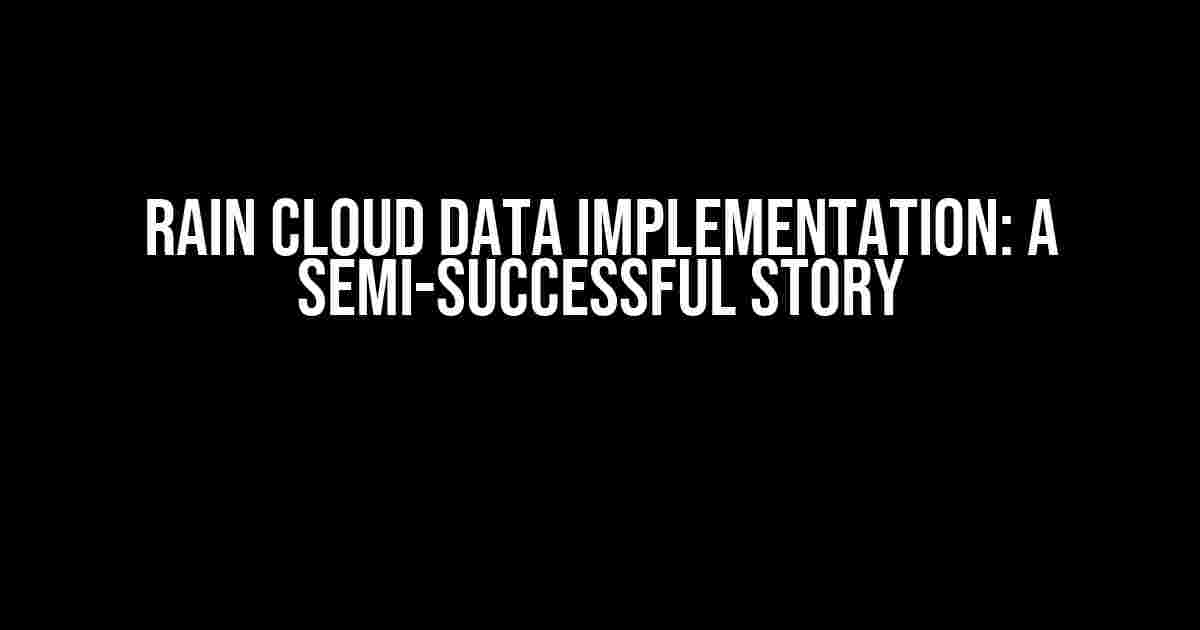If you’re reading this article, chances are you’re trying to implement rain cloud data on a map, but encountered an issue where the map was not visible. Don’t worry, you’re not alone! In this article, we’ll take you through a step-by-step guide on how to implement rain cloud data on a map, highlighting the common pitfalls and solutions to ensure your map is visible and functional.
What is Rain Cloud Data?
Rain cloud data refers to the collection of precipitation data from various sources, such as weather stations, radar, and satellites. This data is crucial for meteorologists, researchers, and developers who need to analyze and visualize precipitation patterns. By implementing rain cloud data on a map, you can create a visually stunning and informative representation of precipitation patterns.
Why Implement Rain Cloud Data on a Map?
Implementing rain cloud data on a map offers several benefits:
- Enhanced visualization: Rain cloud data provides a detailed and accurate representation of precipitation patterns, making it easier to analyze and understand.
- Better decision-making: By having access to real-time precipitation data, researchers, meteorologists, and developers can make informed decisions about weather-related events.
- Improved accuracy: Rain cloud data can be used to validate and improve the accuracy of weather forecasting models.
The Implementation Process
Implementing rain cloud data on a map involves several steps, which we’ll break down into three main sections: preparing the data, setting up the map, and integrating the data with the map.
Preparing the Data
To prepare the rain cloud data, you’ll need to:
- Collect precipitation data from reliable sources, such as weather stations, radar, and satellites.
- Clean and preprocess the data to remove any inconsistencies or errors.
- Format the data in a suitable format for mapping, such as CSV or JSON.
// Example of preprocessed rain cloud data in JSON format
[
{
"lat": 37.7749,
"lon": -122.4194,
"precipitation": 0.5
},
{
"lat": 37.7858,
"lon": -122.4364,
"precipitation": 0.8
},
...
]
Setting up the Map
To set up the map, you’ll need to:
- Choose a mapping library or framework, such as Leaflet or Google Maps.
- Create a basic map with a suitable projection and zoom level.
- Add any necessary layers, such as a basemap or boundary layers.
// Example of setting up a basic map using Leaflet
var map = L.map('map').setView([37.7749, -122.4194], 13);
L.tileLayer('https://{s}.tile.openstreetmap.org/{z}/{x}/{y}.png', {
attribution: '© OpenStreetMap',
subdomains: ['a', 'b', 'c']
}).addTo(map);
Integrating the Data with the Map
To integrate the rain cloud data with the map, you’ll need to:
- Create a layer for the rain cloud data, such as a heatmap or cluster layer.
- Add the preprocessed data to the layer, using the mapping library’s API.
- Customize the layer’s appearance and behavior, as needed.
// Example of integrating rain cloud data with the map using Leaflet
var rainCloudLayer = L.heatLayer([
[37.7749, -122.4194, 0.5],
[37.7858, -122.4364, 0.8],
...
], {
radius: 20,
opacity: 0.7
}).addTo(map);
Troubleshooting Common Issues
If you’re experiencing issues with your map not being visible, check the following common pitfalls:
| Issue | Solution |
|---|---|
| Map container not defined | Ensure that the map container element is defined in the HTML, and has a valid ID. |
| Map library not loaded | Verify that the mapping library’s JavaScript file is loaded correctly, and that the library is initialized properly. |
| Data format incorrect | Check that the rain cloud data is formatted correctly, and that the mapping library’s API is being used correctly. |
| Layer not added to map | Ensure that the rain cloud layer is added to the map correctly, using the mapping library’s API. |
Conclusion
Implementing rain cloud data on a map can be a challenging task, but by following the steps outlined in this article, you should be able to create a functional and informative map. Remember to troubleshoot any issues that arise, and don’t hesitate to seek help if you’re stuck. With practice and patience, you’ll be able to unleash the full potential of rain cloud data on your map.
By the way, if you’re still experiencing issues with your map not being visible, please check the following:
// Make sure the map container has a valid ID
<div id="map"></div>
// Verify that the mapping library is loaded correctly
<script src="https://cdn.jsdelivr.net/npm/[email protected]/dist/leaflet.js"></script>
// Initialize the map correctly
var map = L.map('map').setView([37.7749, -122.4194], 13);
Still stuck? Feel free to ask for help in the comments below!
Frequently Asked Question
Get the scoop on what went wrong with the rain cloud data implementation on the map!
What happened to the rain cloud data on the map?
Unfortunately, the rain cloud data was only partially successful in its implementation on the map. It’s like the clouds decided to hide the map instead of showing it off!
Why wasn’t the map visible?
The rain cloud data implementation got in the way, clouding (pun intended!) the visibility of the map. We’re working on clearing up the issue, so stay tuned!
Is the issue with the rain cloud data or the map itself?
Good question! The issue lies with the implementation of the rain cloud data on the map. The map is fine, but the rain cloud data needs a bit more tweaking to play nice with the map.
How long will it take to fix the issue?
Our team of cloud-whisperers (aka developers) is working diligently to resolve the issue. We expect to have a sunny solution soon, but we can’t give an exact timeline just yet. Stay patient, and we’ll keep you updated!
Will I be able to see the rain cloud data on the map eventually?
Absolutely! Once we’ve ironed out the wrinkles, you’ll be able to see the rain cloud data in all its glory on the map. It’ll be a beautiful, stormy union!

